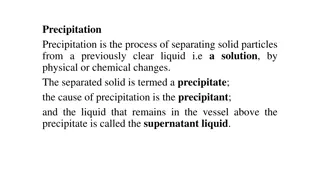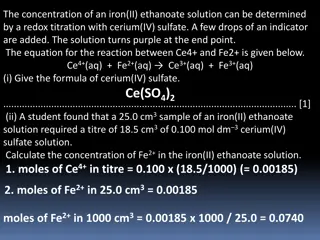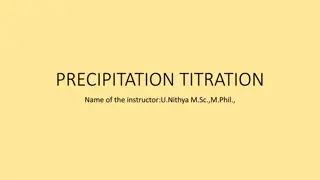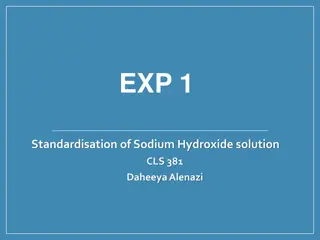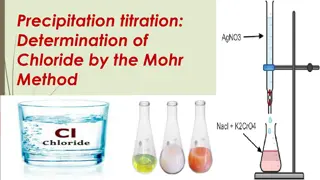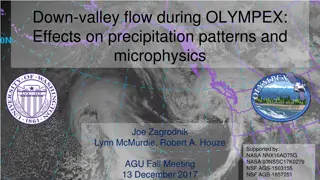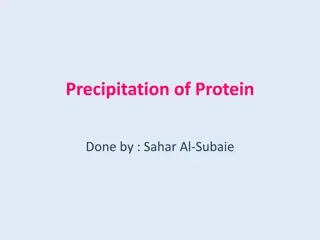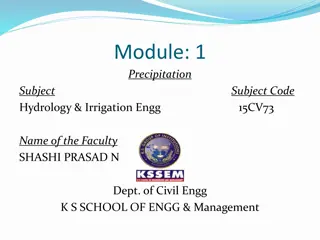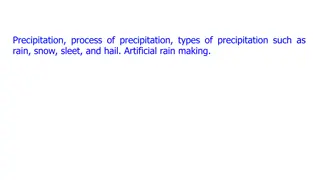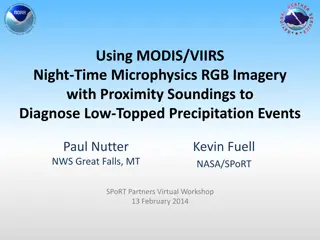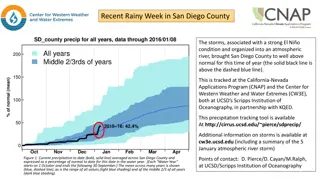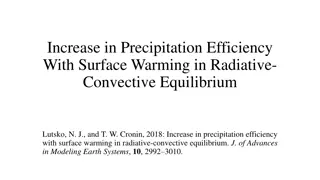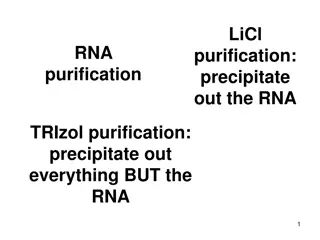Titration Colour Changes
This collection features various experiments in chemistry involving titration and solutions. It includes procedures such as standardizing hydrochloric acid using sodium carbonate, titrating hydrochloric acid with sodium hydroxide to produce sodium chloride, determining the concentration of ethanoic
0 views • 10 slides
Aspirin Assay by Direct Acid-Base Titration Experiment Overview
Exploring the process of assessing aspirin purity through direct acid-base titration using sodium hydroxide as a standard solution. The experiment includes details on aspirin properties, dosage, acidity, decomposition, and metabolism. Key aspects covered include the aim of the experiment, the princi
5 views • 15 slides
Insights into Raindrop Size Distribution and Precipitation Intensity through Radar Technology
Vertical momentum of impacting raindrops can be converted into an electric pulse to analyze raindrop size distribution. Disdrometers using video cameras can directly count raindrops for sizing. Radar technology provides superior data on precipitation accumulation and intensity by measuring radar ref
4 views • 9 slides
Understanding Precipitation and Rainfall Patterns in Hydrology
Exploring the various forms of precipitation like rainfall, snowfall, hail, and sleet, this lesson delves into the complexities of precipitation forms, intensity classifications, types of rain gauges, and methods for correcting deficiencies in rainfall data. Through detailed descriptions and images,
1 views • 39 slides
Belladonna Alkaloids Identification Methods and Analysis
Learn about the qualitative and quantitative analysis methods for identifying belladonna alkaloids. Discover the differences between titration and back-titration, and follow a detailed procedure to quantitatively identify the alkaloids present. Equip yourself with the required equipment and reagents
0 views • 14 slides
Understanding Precipitation in Meteorology
Precipitation in meteorology is the result of atmospheric water vapor condensing and falling to Earth, a vital element of hydrology. It can occur in liquid or solid forms through processes like evaporation, cooling, condensation, and droplet growth. Different geographic and climate conditions impact
0 views • 17 slides
Hydrologic Modeling with Gridded Precipitation Data
Learn about utilizing gridded precipitation data for hydrologic modeling with HEC-HMS. Explore the advantages of spatially distributed precipitation sources such as RADAR and gauge comparisons, and understand the various national and regional products available. Discover utilities for converting and
3 views • 14 slides
Understanding Precipitation in Pharmacy and Chemistry
Precipitation is a crucial process in chemistry and pharmacy, where solid particles are separated from a clear liquid solution. This method is used for various purposes like obtaining fine particles, purifying powders, and preparing pharmaceutical substances. Examples include calcium carbonate, ammo
7 views • 10 slides
Chemical Analysis and Redox Reactions in Chemistry
Iron(II) ethanoate concentration determination using redox titration with cerium(IV) sulfate, balanced redox equations for manganate(VII) ion oxidizing iron(II) ion, and calculations of iron percentage in samples using titration with potassium manganate(VII). Molarities and concentrations are calcul
1 views • 6 slides
Understanding Antigen-Antibody Precipitation Reaction in Microbiology
Antigen-antibody precipitation reaction involves the formation of insoluble products when a soluble bivalent antibody interacts with a soluble antigen. This reaction leads to the formation of a visible precipitate known as a lattice. The mechanism of precipitation, including the prozone phenomenon,
0 views • 20 slides
Understanding Precipitation Titration in Analytical Chemistry
Precipitation titration is a method where a precipitate is formed by converting one reacting species. An example is the estimation of chloride using AgNO3, where AgCl is precipitated. The titration is based on the formation of precipitates, and suitable conditions, indicators, and methods are vital
0 views • 30 slides
Overview of Ammonium Chloride: Properties, Preparation, and Uses
Ammonium Chloride, with the formula NH4Cl, is a compound containing not less than 99.5% NH4Cl. It is prepared commercially by neutralizing ammonia with hydrochloric acid or treating ammoniacal gas liquors with lime. The compound is essential for maintaining acid-base equilibrium, acts as an expector
2 views • 4 slides
Understanding Milk Freshness and Quality Control
Milk freshness is crucial for maintaining optimal nutrient composition and preventing excessive acidity due to microbial activity. Various tests and analyses are conducted to assess the freshness and appropriateness of milk for further processing, with titration methods being a common approach for m
2 views • 7 slides
Back Titration in Analytical Chemistry
Back titration is a technique used in analytical chemistry to determine the concentration of an analyte by reacting it with an excess of another reagent first, followed by titration of the excess reactant. This method is especially useful in cases where direct titration endpoints are difficult to di
2 views • 14 slides
Standardisation of Sodium Hydroxide Solution Experiment
The experiment focuses on the standardisation of sodium hydroxide solution using potassium hydrogen phthalate by titration method. It discusses the types of standard solutions, criteria of primary standards, and the difference between standardisation and titration methods. The objective is to determ
1 views • 26 slides
Understanding Antigen-Antibody Interactions and Diagnostic Tests
Antigen-antibody interactions are essential in immunology, determining disease presence, blood types, and more. Diagnostic tests such as agglutination and precipitation reactions play a crucial role. Specimen collection involves obtaining blood samples for analysis, while precipitation reactions for
0 views • 22 slides
Determination of Chloride by Mohr Method
Precipitation titration is a volumetric method used for determining chloride ions. Mohr's method involves reacting alkaline or alkaline earth chlorides with silver nitrate in the presence of a potassium chromate indicator. The endpoint of the titration is signaled by the appearance of red silver chr
0 views • 9 slides
Contractions of Tropical Precipitation Under Global Warming
Aaron Donohoe's research focuses on the contraction of tropical precipitation with global warming, emphasizing the zonal mean and its implications for climate models. The results show a robust contraction and intensification of tropical precipitation in a warmer world. The width of tropical precipit
0 views • 12 slides
Insights into Precipitation Analysis for Transportation Applications
Delve into the utilization of precipitation data by state transportation agencies for road and bridge design, safety operations, and traveler information. Explore model components and the nature of precipitation events, along with challenges associated with spatial scale sampling. Discover the impor
4 views • 12 slides
Impact of Precipitation on Ocean Salinity: Study at University of Antananarivo
Juliette Soanaoly from the University of Antananarivo presents a study on the impact of precipitation on ocean salinity. The research explores the intercorrelation between rainfall and salinity, variability of precipitation in a specific study area, and the methodologies used to analyze the data ove
1 views • 17 slides
Effects of Down-Valley Flow on Precipitation Patterns and Microphysics
Down-valley flow in complex terrain areas like the Alps and British Columbia modifies precipitation patterns through diabatic cooling and melting effects. Observations from the OLYMPEX field campaign show how down-valley flow is influenced by both thermodynamics and pressure gradients, with signific
0 views • 15 slides
Protein Denaturation and Precipitation: Mechanisms and Effects
Protein denaturation is a process where proteins lose their native structure due to external factors like heat, strong acids, or bases. This leads to protein aggregation and precipitation. Different types of denaturation exist, including reversible and irreversible forms. Strong mineral acids can al
1 views • 21 slides
Forms of Precipitation and How They Form
Precipitation is any form of water that falls to earth and occurs when water evaporates into the atmosphere, saturates it, then condenses back into water. There are 5 main types of precipitation: rain, sleet, hail, snow, and freezing rain. Rain forms as water droplets in clouds collide and grow too
1 views • 14 slides
Understanding Precipitation: Forms and Types Explained
Precipitation, any form of moisture reaching Earth's surface from the atmosphere, encompasses various types like rain, snow, drizzle, glaze, sleet, and hail. Each type has unique characteristics, densities, and formation processes. Additionally, precipitation can be classified into convection, cyclo
1 views • 38 slides
Assay of Aspirin by Indirect Acid-Base Titration
Indirect titration, also known as residual titration, is an analytical technique used to determine the weight of an unknown sample by employing excess standard solution. In the case of aspirin, which is a weak acid undergoing slow hydrolysis, back titration with NaOH and HCl is utilized to overcome
1 views • 13 slides
Understanding Acid-Base Titration in Analytical Chemistry
Analytical chemistry involves analyzing material samples to determine their chemical composition. Acid-base titration is a technique used to find the concentration of an unknown solution by reacting it with a known concentration solution. This process, involving neutralization reactions and pH indic
0 views • 4 slides
Understanding Precipitation: Process, Types, and Artificial Rain Making
Precipitation occurs through the condensation of water vapors in the air. The process involves various types such as rain, snow, sleet, and hail, each formed differently - convectional, orographic, and frontal/cyclonic. Learn about the mechanisms behind precipitation, including the creation of artif
1 views • 25 slides
Understanding Cloud and Precipitation Processes in Atmospheric Science
This week's module focuses on measuring, predicting, and modeling single-column processes related to clouds and precipitation. Topics covered include ODE and PDE models, advection equations, orographic clouds, warm and cold cloud processes, condensation, warm-rain processes, and more. The importance
0 views • 17 slides
Enhancing Precipitation Interpolation Methods for High-Resolution Data Analysis
Accurate interpolation of precipitation data is crucial for various applications, especially in regions with limited data coverage like Greece. This study focuses on improving the creation of a precipitation atlas for Greece using daily observation analysis. By analyzing the reliability of the metho
0 views • 24 slides
Estimation of Precipitation over the OLYMPEX Domain during Winter 2015-2016
The study aims to evaluate precipitation products over the OLYMPEX domain during the winter of 2015-2016 by utilizing various data sources such as NOAA, NASA, and in-situ observations. The primary goal is to enhance the assessment of Global Precipitation Mission (GPM) products, focusing on regions w
0 views • 22 slides
Diagnosing Low-Topped Precipitation Events Using Satellite Imagery
Utilizing MODIS/VIIRS Night-Time Microphysics RGB Imagery combined with Proximity Soundings can enhance situational awareness and aid in diagnosing low-topped precipitation events. Various satellite images and data sources are analyzed to understand why heavy rain occurred in Havre, MT, despite mini
0 views • 17 slides
Determination of Bicarbonate in Blood Using Back Titration
Back titration is an analytical chemistry technique used to determine the concentration of an analyte, such as bicarbonate in blood. This method involves reacting the analyte with an excess reagent, followed by back-titrating the remaining excess and relating it to the original sample's concentratio
0 views • 21 slides
Understanding Antigen-Antibody Precipitation Reaction in Immunity
The humoral basis of immunity involves the specific reaction between antigens and antibodies, resulting in the formation of insoluble precipitates through a process called precipitation. This reaction plays a crucial role in immune responses against infectious diseases, influenced by factors like af
0 views • 16 slides
Protein Purification Techniques and Ammonium Sulfate Precipitation
Protein purification is a crucial process in biotechnology to isolate specific proteins from complex mixtures. Techniques such as exploiting physio-chemical properties, binding affinity tags, and biological activity are used. Ammonium sulfate precipitation, a common first step, involves adding incre
0 views • 60 slides
Impressive Impact of Recent El Niño-Fueled Storms in San Diego County
El Niño-driven storms in San Diego County led to above-average winter precipitation, with areas receiving over 5 inches of rain in just 3 days. This sudden increase has significantly boosted accumulated precipitation levels for the winter, especially in Southern California. The rapid rise in precip
1 views • 5 slides
Increase in Precipitation Efficiency with Surface Warming
The study examines how surface warming affects precipitation efficiency in radiative-convective equilibrium. Various factors influencing precipitation efficiency, such as microphysical processes and climate sensitivity, are discussed. Model experiments are conducted to test the sensitivity of precip
0 views • 33 slides
Understanding the Titration of Weak Acids and Amino Acids
Titration is a crucial technique used to determine the properties of weak acids and amino acids. This process involves calculating pH values, degree of ionization, and understanding the ionization equilibrium of different acid-base systems. Various examples, including glycine hydrochloride, isoelect
0 views • 15 slides
Methods for RNA Purification and Separation from DNA
Selective precipitation of RNA using Lithium Chloride (LiCl) and extraction with phenol at acidic pH are two common methods for separating RNA from DNA. LiCl forms a complex with RNA facilitating its precipitation, while acidic phenol solution helps stabilize RNA at pH 4-5 for extraction. TRIzol var
0 views • 7 slides
Assay of NaOH Solution - Lab Procedure for Determining Sodium Hydroxide Content
This essay discusses the assay of NaOH solution, focusing on the two-step titration process involving NaOH and HCl for determining the concentration of NaOH. Detailed procedures, chemical factors, and calculations for both titration steps are explained in depth. The analysis also includes the ration
0 views • 10 slides
Analyzing Precipitation Titrations and Spectroscopy in Chemistry Lecture
Exploring the concepts of precipitation titrations and spectroscopy in a chemistry lecture covering topics such as titration curves, sharpness at equivalence points, and titration of mixtures. The lecture delves into examples like the titration of Hg2^2+ by CrO4^2-, emphasizing the three regimes bef
0 views • 17 slides







